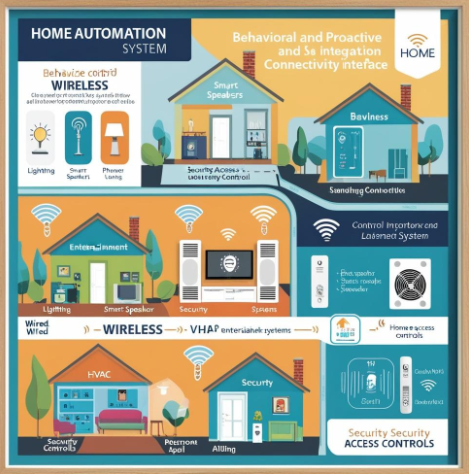The smart home automation market is experiencing rapid growth, driven by advancements in IoT, AI, and connectivity. Consumers increasingly seek convenience, energy efficiency, and enhanced security, which has led to the integration of smart devices across residential spaces. Automation solutions, from lighting and climate control to security systems, are revolutionizing the way people interact with their homes. As the market evolves, emerging trends such as 5G connectivity, voice-controlled assistants, and AI integration continue to shape the future of smart home technology.
Current Trends in Smart Home Automation
Several trends are reshaping the smart home market:
- Increased Integration of AI and IoT: AI-powered smart homes can learn and adapt to user preferences, optimizing energy usage, comfort, and convenience. IoT connects various devices, enabling seamless communication and automation throughout the home.
- Rise of Voice Assistants: With voice assistants like Amazon Alexa, Google Assistant, and Apple Siri, voice control has become one of the most popular ways to interact with smart home systems.
- Affordable and Accessible Devices: As the cost of smart devices continues to decrease, consumers are more willing to adopt home automation solutions. This has driven widespread adoption across various demographics.
Download PDF Brochure @ https://www.marketsandmarkets.com/pdfdownloadNew.asp?id=469

Impact of Smart Home Automation on Energy Efficiency
Smart home systems contribute significantly to energy efficiency. Through intelligent thermostats, lighting controls, and energy monitoring systems, homes can reduce energy consumption by optimizing heating, cooling, and lighting. These systems adjust according to occupancy or weather patterns, minimizing waste. The result is lower energy bills and a reduced carbon footprint, appealing to environmentally conscious consumers.
Security Challenges in Smart Home Systems
While smart home automation enhances security, it also introduces new risks. Cybersecurity vulnerabilities, such as unsecured networks, unencrypted data, and weak authentication mechanisms, make smart homes targets for hackers. Privacy concerns also arise, especially with devices that collect personal data. To address these issues, manufacturers are investing in stronger encryption methods, multi-factor authentication, and constant security updates.
The Role of AI and IoT in Home Automation
AI and IoT are central to the evolution of smart homes. IoT connects smart devices to the internet, allowing them to communicate and function together. AI, on the other hand, helps automate tasks and make smart systems more intuitive. For example, AI-driven thermostats can learn household routines and adjust temperatures accordingly. Similarly, AI-powered security systems can detect unusual activity and alert homeowners in real time.
Home Automation in Security and Surveillance
Home automation has significantly improved security and surveillance systems. Smart cameras, motion sensors, and video doorbells are some of the most commonly used security devices in smart homes. These systems allow homeowners to monitor their property remotely and receive alerts when suspicious activity is detected. With the integration of AI, surveillance systems can distinguish between different types of movement, reducing false alarms.
Innovations in Smart Home Technology
Innovation continues to drive the smart home sector. Some notable advancements include:
- Smart Appliances: Appliances like refrigerators, washing machines, and ovens are becoming smarter, with remote control features and AI-based energy optimization.
- Smart Lighting: Beyond simple on/off control, modern smart lighting systems can adjust brightness, color, and even sync with music or movies.
- Wearable Integration: Integration of smart home systems with wearable devices is also on the rise, allowing users to control their environment from their wrist.
Emerging Trends in Home Automation
The future of home automation will be shaped by emerging trends:
- Voice-Activated Control: As voice technology becomes more advanced, voice commands will increasingly replace manual controls, allowing for a more seamless smart home experience.
- Health and Wellness Monitoring: Smart homes are incorporating health-monitoring devices such as air quality sensors, fitness trackers, and sleep aids to improve residents’ well-being.
- Elderly and Assisted Living: Smart home technology is being tailored for elderly care, with features like fall detection, remote monitoring, and medication reminders.
The Role of 5G in Smart Homes
5G connectivity is expected to revolutionize smart homes by enabling faster and more reliable communication between devices. With 5G, the latency in smart home systems will be significantly reduced, improving real-time interaction between devices. This is especially important for applications such as smart security, where instant alerts and remote monitoring are crucial. Furthermore, 5G will support the growing number of IoT devices in a smart home, providing higher bandwidth and ensuring seamless communication across various platforms.
Key Players in the Smart Home Automation Market
The smart home automation market is highly competitive, with numerous companies offering innovative solutions. Key players include:
- Amazon: With its Alexa ecosystem, Amazon leads the voice assistant market and offers a wide range of smart home devices.
- Google: Google’s Nest platform offers products such as thermostats, security cameras, and smoke alarms.
- Apple: Known for its HomeKit platform, Apple provides seamless integration across smart home devices, with a focus on security and privacy.
- Samsung: Samsung’s SmartThings ecosystem enables users to control a variety of smart home devices through a single app.
- Honeywell: A leader in home automation, Honeywell offers smart thermostats, security systems, and air quality monitors.
The smart home automation market is poised for continued growth, driven by advancements in AI, IoT, and connectivity. As consumers seek more convenience, security, and energy efficiency, smart homes are becoming an integral part of modern living. Innovations such as voice assistants, 5G connectivity, and AI-driven automation will continue to enhance user experience and shape the future of home automation. However, as the industry grows, addressing security concerns and ensuring seamless device integration will remain key challenges for both consumers and manufacturers.
